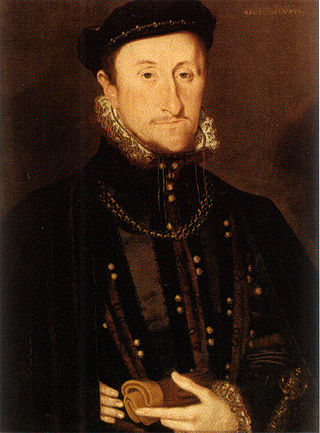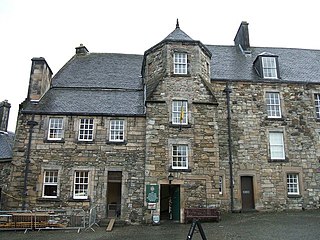Related Research Articles

Mary, Queen of Scots, also known as Mary Stuart or Mary I of Scotland, was Queen of Scotland from 14 December 1542 until her forced abdication in 1567.

James Stewart, 1st Earl of Moray was a member of the House of Stewart as the illegitimate son of King James V of Scotland. At times a supporter of his half-sister Mary, Queen of Scots, he was the regent of Scotland for his half-nephew, the infant King James VI, from 1567 until his assassination in 1570. He was the first head of government to be assassinated with a firearm.

Agnes Randolph, Countess of Dunbar and March, known as Black Agnes for her dark complexion, was the wife of Patrick, 9th Earl of Dunbar and March. She is buried in the vault near Mordington House.

Charles Scott Dickson, Lord Dickson, FRSE LLD was a Scottish Unionist politician and judge.

Clan Sutherland also known as House of Sutherland is a Highland Scottish clan whose traditional territory is the shire of Sutherland in the far north of Scotland. The chief of the clan was also the powerful Earl of Sutherland; however, in the early 16th century, this title passed through marriage to a younger son of the chief of Clan Gordon. The current chief is Alistair Sutherland, who holds the title Earl of Sutherland.

Dunbar Castle was one of the strongest fortresses in Scotland, situated in a prominent position overlooking the harbour of the town of Dunbar, in East Lothian. Several fortifications were built successively on the site, near the English-Scottish border. The last was slighted in 1567; it is a ruin today.

Nicola Joy Nadia Benedetti is an Italian-Scottish classical solo violinist and festival director. Her ability was recognised when she was a child, including the award of BBC Young Musician of the Year when she was 16. She works with orchestras in Europe and America as well as with Alexei Grynyuk, her regular pianist. Since 2012, she has played the Gariel Stradivarius violin.
George Gordon, 2nd Earl of Huntly was a Scottish nobleman and Chancellor of Scotland from 1498 to 1501.

The murder of Henry Stuart, Lord Darnley, second husband of Mary, Queen of Scots, took place on 10 February 1567 in Edinburgh, Scotland. Darnley's lodgings were destroyed by gunpowder; his body and that of his servant were found nearby, apparently having been strangled rather than killed in the explosion. Suspicion was placed upon Queen Mary and the Earl of Bothwell, whom Mary went on to marry three months after Darnley's murder. Bothwell was indicted for treason and acquitted, but six of his servants and acquaintances were subsequently arrested, tried, and executed for the crime.

Princess Joan Stewart, Countess of Morton, also called Joanna, was the daughter of James I, King of Scotland, and the wife of James Douglas, 1st Earl of Morton. She was known, in Latin, as the muta domina [mute lady] of Dalkeith.
Anna Shuttleworth was a British cellist. She studied cello with Ivor James and Harvey Phillips at the Royal College of Music and later became a professor at the same college. Her pupils include Alexander Baillie, Martin Johnson, Natalie Clein, František Brikcius, and Kathy Hampson.

Darnaway Castle, also known as Tarnaway Castle, is located in Darnaway Forest, 3 miles (5 km) southwest of Forres in Moray, Scotland. This was Comyn land, given to Thomas Randolph along with the Earldom of Moray by King Robert I. The castle has remained the seat of the Earls of Moray ever since. Rebuilt in 1810, it retains the old banqueting hall, capable of accommodating 1,000 people.
Margaret Graham, Countess of Menteith was a Scottish noblewoman. She held the title Countess of Menteith in her own right, having inherited the title c. 1360 from her mother, Mary, Countess of Menteith, who was married to Sir John Graham. Graham was styled Earl of Menteith during his marriage with Mary, whom he predeceased. The Menteith region was situated partially in southwest Perthshire and partly in Stirlingshire.

William Keith, 4th Earl Marischal was a Scottish nobleman and politician.

Lady Frances Balfour was a British aristocrat, author, and suffragist. She was one of the highest-ranking members of the British aristocracy to assume a leadership role in the Women's suffrage campaign in the United Kingdom. Balfour was a member of the executive committee of the National Society for Women's Suffrage from 1896 to 1919. As a non-violent suffragist, she was opposed to the militant actions of the Women's Social and Political Union, whose members were called the suffragettes.
Events from the year 1848 in Scotland.
Margaret Ida Balfour, FRCOG was a Scottish medical doctor and campaigner for women’s medical health issues, who made a significant contribution to the development of medicine in India. Her prolific writing during the early 20th century alerted many to the health needs of women and children in India and Africa and the unhealthy environments in which they lived.

Hester Dickson Martineau was a celebrated Scottish pianist and pedagogue who was born in Edinburgh.
Servais de Condé or Condez was a French servant at the court of Mary Queen of Scots, in charge of her wardrobe and the costume for masques performed at the Scottish royal court.

Walter Merlioun, was a Scottish master mason based in Edinburgh.
References
- 1 2 3 Ewan, Elizabeth; Innes, Sue; Reynolds, Siân; Pipes, Rose, eds. (2006). The Biographical Dictionary of Scottish Women . Edinburgh: Edinburgh University Press. pp. 95. ISBN 9780748632930.
- ↑ "Joan Dickson 1921-1994: Joan's Memorial Celebration 25 March 1995". Moray Welsh, Cellist, Painter. Retrieved 27 December 2016.